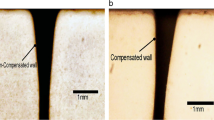Abstract
As the only cold high-energy beam machining technology, abrasive water-jet (AWJ) is one of the most rapidly developed techniques in material manufacturing industry. However, the application of AWJ is limited by the cutting accuracy it can achieve. Kerf profile generated by AWJ is different as the cutting parameters change. As a result, it has become a major factor which affects the cutting accuracy when AWJ is used as a machining tool. Researchers used taper error to characterize kerf profile error generated by AWJ in the past years. And many efforts have been put on how to eliminate taper error by using a tilting cutting head of a 5-axis AWJ machine. However, using taper error to characterize the kerf profile error generated by AWJ is not accurate since kerf profile error might appear in different styles. And using a 5-axis AWJ machine to eliminate taper error is only effective in some special cases. To effectively eliminate taper error, the first thing needs to do is to find out whether the kerf profile error can be compensated or not. Based on research, a key parameter, named kerf profile coefficient O, which can be used to characterize kerf profile error and further to guide people to use different ways to compensate kerf profile error, has been defined in this paper. To further illustrate the efficiency of this coefficient, a series of cutting experiments have been carried out and the experimental results have been discussed.
Similar content being viewed by others
References
Matsui S, Matsumura H, Ikemoto Y, Tsujita K, Shimizu H (1990) High precision cutting method for metallic materials by abrasive waterjet. In: proceedings of the 10th international symposium on jet cutting technology. Amsterdam, pp 263–278
Zeng J, Henning A (2009) Kerf characterization in abrasive waterjet cutting. In: 2009 American WJTA conference and expo. Houston, pp 1-H
Hashish M (2004) Precision cutting of thick materials with AWJ. In: BHR group 2004 water jetting, pp 33–46
Hashish M (2007) Benefits of dynamic waterjet angle compensation. In: 2007 American WJTA conference and expo. Houston, pp 2007:1-H
Maccarini G, Monno M, Pellegrini G, Ravasio C (2008) Characterization of the AWJ kerf: the influence of material properties. In: the 19th international conference on water jetting. Nottingham, pp 67–76
Hlavác LM, Hlavácová IM, Geryk V (2016) Taper of kerfs made in rocks by abrasive water jet (AWJ). In: International journal of advanced manufacturing technology, pp 1–7
Kechagias J, Petropoulos G, Vaxevanidis N (2012) Application of Taguchi design for quality characterization of abrasive water jet machining of TRIP sheet steels. Int J Adv Manuf Technol 62(5–8):635–643
Li H, Wang J (2015) An experimental study of abrasive waterjet machining of Ti-6Al-4V. Int J Adv Manuf Technol 81(1):1–9
Hlavác LM, Hlavácová IM, Geryk V, Plancár Š (2014) Investigation of the taper of kerfs cut in steels by AWJ. Int J Adv Manuf Technol 77(9–12):1811–1818
Chung Y, Geskin ES, Singh P (1992) Prediction of the geometry of the kerf created in the course of abrasive waterjet machining of ductile materials, Jet Cutting Technology. Springer Netherlands, pp 525–541
Groppetti R, Gutema T, Lucchio AD (1998) A contribution to the analysis of some kerf quality attributes for precision abrasive waterjet cutting. In: the 14th international conference on jetting technology. Brugge, pp 253–269
Annoni M, Monno M (2000) A lower limit for the feed rate in AWJ precision machining. In: proceedings of the 15th international conference on jetting technology. Ronneby, pp 285–296
Olsen J, Zeng J, Guglielmetti B (2003) Advanced error correction methodology applied to abrasive waterjet cutting. In: proceedings of the 2003 WJTA American waterjet conference. Houston, pp 5-D
Hashish M (1984) A modeling study of metal cutting with abrasive waterjets. J Eng Mater Technol Trans ASME 106(1):88–100
Zeng J (1992) Mechanisms of brittle material erosion associated with high pressure abrasive waterjet processing—a modeling and application study, Dissertation
Zeng J, Olsen J, Olsen C, Guglielmetti B (2005) Taper free abrasive waterjet cutting with a tilting head. In: 2005 WJTA American waterjet conference. Houston, pp 7A-2
Shanmugam DK, Wang J, Liu H (2008) Minimisation of kerf tapers in abrasive waterjet machining of alumina ceramics using a compensation technique. Int J Mach Tools Manuf 48(14):1527–1534
Author information
Authors and Affiliations
Corresponding author
Rights and permissions
About this article
Cite this article
Wang, S., Zhang, S., Wu, Y. et al. A key parameter to characterize the kerf profile error generated by abrasive water-jet. Int J Adv Manuf Technol 90, 1265–1275 (2017). https://doi.org/10.1007/s00170-016-9402-x
Received:
Accepted:
Published:
Issue Date:
DOI: https://doi.org/10.1007/s00170-016-9402-x



